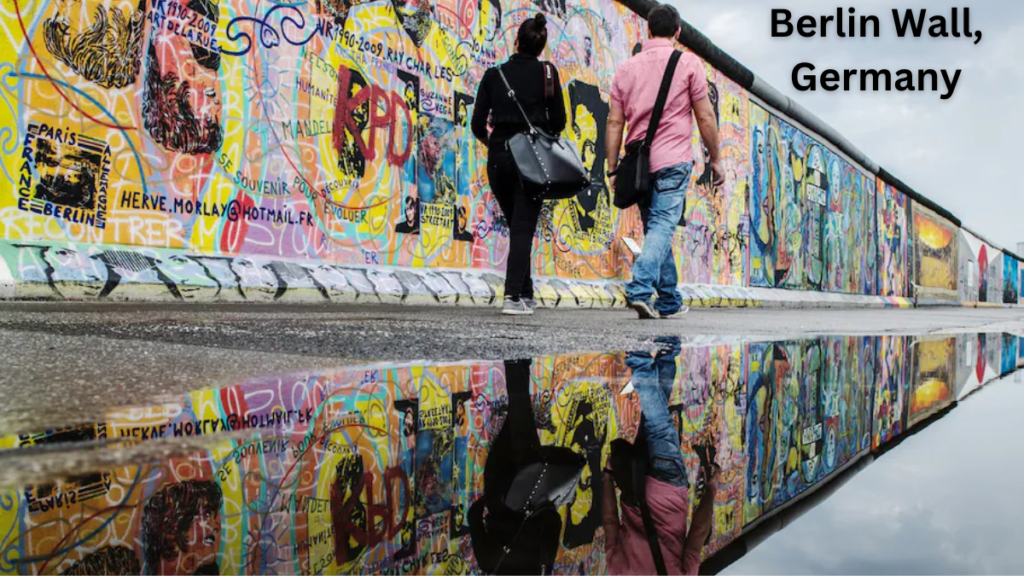Introduction
The Berlin Wall is one of the most iconic symbols of the 20th century, standing as a constant reminder of a divided world during the Cold War. Erected in 1961, this stark barrier divided East and West Berlin and separated families, friends, and even ideologies for almost 30 years. While it was a physical wall of concrete and barbed wire, its emotional impact was far more profound. The Berlin Wall became the dividing line between the freedom of the West and the oppressive regime of the East. Today, it serves as a powerful symbol of peace, unity, and the triumph of human spirit over division.
The Wall’s rise and eventual fall represent a pivotal chapter in world history. Its construction marked a deepening of the Cold War, and its collapse symbolized the end of that era. From its rise, when families were torn apart overnight, to the fall, when joyous crowds reunited in celebration, the Berlin Wall’s journey is a tale of struggle, resilience, and hope. So, grab your passport, because we’re about to take a walk through history and explore the rise and fall of the Berlin Wall!

The Construction of the Berlin Wall
In the early 1960s, tensions between East and West were at an all-time high. After the end of World War II, Germany was split into two halves: the capitalist West, controlled by the Allies, and the communist East, which was under Soviet influence. Berlin, despite being deep in the Soviet-controlled East, was also divided into East and West. But as more and more East Germans fled to the West through Berlin, East Germany’s government faced a growing crisis. Thousands of people, disillusioned with the oppressive regime, were escaping in search of freedom, and the East was losing its workforce.
To stop this exodus, East Germany’s government decided to build the Berlin Wall on August 13, 1961. Overnight, families were separated, streets were blocked, and the once-bustling city became a divided ghost town. The Wall, originally a barbed wire fence, was quickly reinforced with concrete, guard towers, and armed patrols. What started as a simple attempt to “stop the bleeding” became a massive symbol of the ideological and physical divide between East and West, both of Berlin and the world at large. It wasn’t just a wall of concrete—it was a wall of fear, control, and propaganda.
Life in Divided Berlin
Living in a divided Berlin was a daily exercise in navigating the complex boundaries of the Wall. In West Berlin, life continued much as it had, with bustling streets, prosperity, and freedom of expression. Meanwhile, in East Berlin, the reality was starkly different. Citizens lived under strict surveillance by the Stasi, East Germany’s secret police, and faced constant restrictions on travel and expression. The Wall didn’t just divide a city—it divided families, hearts, and hopes.
Imagine waking up in the morning to see a wall blocking your view of loved ones, your favorite spots, or even the way you lived your life. For many East Berliners, the Wall symbolized a lifetime of longing, as they were cut off from the vibrant life in the West. Meanwhile, West Berliners lived in constant awareness that their city was encircled by danger and control. Yet, despite the fear and tension, life went on—through the Wall, people still tried to escape, and stories of courage and resilience flourished. The Berlin Wall was a constant, but so was the will to break free.
Key Events During the Wall’s Existence
The Berlin Wall wasn’t just a passive structure; it was a stage for dramatic events that shaped world history. One of the most memorable moments occurred in 1963 when U.S. President John F. Kennedy visited West Berlin and gave his iconic speech, declaring, “Ich bin ein Berliner” (“I am a Berliner”). This heartfelt gesture of solidarity boosted the morale of West Berliners, showing the world that freedom would not be abandoned.
Over the years, countless stories of daring escapes emerged, from hot air balloon flights to digging tunnels under the Wall. Perhaps the most famous escape occurred in 1964, when 57 East Germans used a tunnel to escape to the West, highlighting the lengths people would go to for freedom. However, these escapes weren’t without risks—many were caught and severely punished. The Wall wasn’t just a physical barrier; it was a psychological one, too, a symbol of the constant threat of surveillance, control, and separation. Despite all odds, the human desire for freedom remained unshaken.
The Fall of the Berlin Wall: The Turning Point
November 9, 1989, will forever be etched in the hearts of Berliners and people around the world as the day the Berlin Wall came down. But the path to that historic moment was anything but straightforward. Throughout the late 1980s, political and economic reforms in the Soviet Union, led by Mikhail Gorbachev, brought about significant change. The policies of glasnost (openness) and perestroika (restructuring) encouraged East Germans to push for greater freedom.
By November, protests erupted in East Germany, demanding reforms. The government, already under pressure, was hesitant to act decisively. On that fateful evening, a government spokesperson mistakenly announced that East Germans could immediately cross the border into the West. The confusion led thousands of Berliners to swarm to the Wall, overwhelming border guards who, unprepared and unsure, opened the gates. The Wall came down almost overnight, and jubilant crowds from both sides of Berlin flooded together, celebrating their newfound freedom. It was a spontaneous and euphoric moment that changed the course of history.
The Aftermath: Reunification of Germany
After the fall of the Berlin Wall, the world watched in awe as the people of Germany celebrated their hard-won freedom. The physical and emotional barriers between East and West came crashing down, but reunification was no simple task. The process was fraught with challenges: the integration of two vastly different economies, the rebuilding of a fractured nation, and the reconciling of decades of ideological differences. East Germany, with its centrally planned economy, lagged behind West Germany in terms of economic development and infrastructure.
Despite these hurdles, reunification was officially completed on October 3, 1990, just under a year after the Wall fell. This marked the end of nearly 45 years of division, both for Germany and for the wider world. The reunification wasn’t just political—it was deeply personal, as families who had been torn apart by the Wall could now reunite, physically and emotionally. The fall of the Berlin Wall signaled the end of the Cold War and was a powerful reminder that division doesn’t last forever, especially when people long for unity and freedom.
Preserving the Memory: Berlin Wall Memorials and Museums
Today, Berlin is home to several memorials and museums dedicated to preserving the history of the Wall. One of the most poignant sites is the Berlin Wall Memorial on Bernauer Strasse, where a preserved stretch of the Wall stands as a reminder of the struggles people faced. The memorial includes historical exhibitions, photographs, and a viewing platform, allowing visitors to reflect on the human cost of the Wall.
Another must-visit is the East Side Gallery, a 1.3-kilometer-long stretch of the Wall covered in murals and artwork that tell the story of freedom and resistance. These murals have become a symbol of hope, resilience, and the creative spirit that flourished even in the face of oppression. As you walk through Berlin today, the remnants of the Wall offer a powerful experience, letting visitors connect with history on a personal level.
Legacy of the Berlin Wall
The Berlin Wall’s legacy is much more than a story of division. It stands as a powerful reminder of how far the human spirit can go to overcome oppression and the desire for freedom. The Wall’s fall heralded the end of an era—the end of the Cold War, the reunification of Germany, and the collapse of communist regimes in Eastern Europe. The Wall’s story also serves as a cautionary tale about the dangers of division, showing us that physical and ideological barriers can only last for so long before the yearning for unity prevails.
Even now, decades after its fall, the Berlin Wall continues to influence global politics and culture. It’s not just a historical landmark; it’s a touchstone for anyone who believes in freedom and equality. Whether through memorials, museums, or the stories of those who lived through it, the Berlin Wall’s legacy will continue to remind us of the power of human resilience and the importance of peace and unity.
Visiting the Berlin Wall Today: What You Can See
If you ever find yourself in Berlin, there are several places where you can walk in the footsteps of history and witness the remnants of the Berlin Wall. The Berlin Wall Memorial and the East Side Gallery are just the beginning. You can also visit Checkpoint Charlie, the famous border crossing, which now houses a museum detailing the Wall’s history and the daring escapes that took place there.
For those who want to explore beyond the main sites, there are smaller sections of the Wall scattered across the city, along with informative plaques that tell the stories of those who lived through the divide. Berlin is a city that has embraced its past, and visiting these sites will give you a deeper appreciation for the monumental change that took place here. Each brick, each piece of the Wall, tells a story that still resonates with the world today.
Conclusion: The Wall That Changed History
The Berlin Wall was not just a physical barrier; it was a symbol of division, fear, and oppression. Its rise and fall represent a pivotal moment in history, a moment when the world saw that the human desire for freedom could not be contained.






